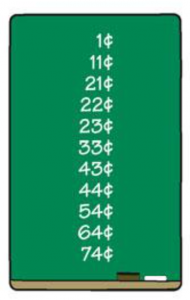Totaling Dimes and Pennies
Purpose
To add 10 or add 1 to any number using dimes and pennies
Materials
For the teacher: 9 dimes, 9 pennies
Overview
Select coins at random from a container of dimes and pennies. (You should have no more than nine of each type of coin, so that children will not have to regroup to find the value).
Show each coin to the class as you choose it and call on a child to tell you the current total. You may want to record this running total in a column on the board to help children see that adding a dime changes only the tens digit while adding a penny changes only the ones digit. Then place the coin in one of two piles—dimes or pennies. Every now and then, you can check the current total by looking at the coins on your desk. “Kia says the total is 74¢. How many dimes do we have? How many pennies do we have?”

About the sequence
Part 1 begins using only dimes to add 10 to a given number. Part 2 includes dimes and pennies.
Part 1
(Have a child pick out some pennies from a jar to get a starting number). We’re going to start with ____ cents. Every time we add one dime to our collection we’ll add 10! (Repeat examples as necessary)
Example (starting with 7¢):
- 7¢, 17¢, 27¢, 37¢, 47¢, 57¢, 67¢, 77¢, 87¢, 97¢
While children are enjoying their building of mastery, feel free to repeat. When children are eager for more, try Part 2.
Part 2
(Have a child pick out some pennies from a jar to get a starting number). We’re going to start with ____ cents. Every time we add one dime to our collection we’ll add 10 and every time we add one penny to our collection we’ll add 1.
Example:
- 7¢
- 17¢ (dime)
- 18¢ (penny)
- 28¢ (dime)
- 38¢ (dime)
- 39¢ (penny)
- 40¢ (penny)
- 41¢ (penny)
- 51¢ (dime)
- 61¢ (dime)

This work is licensed under a
Creative Commons Attribution-NonCommercial-NoDerivatives 4.0 International License.
